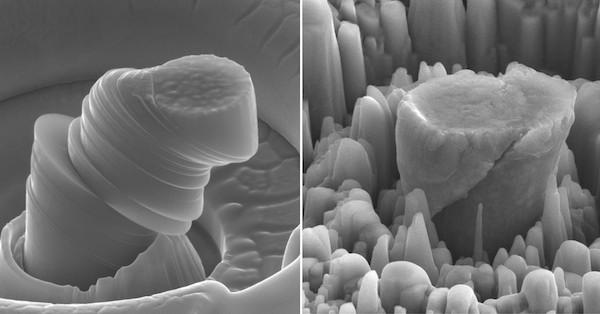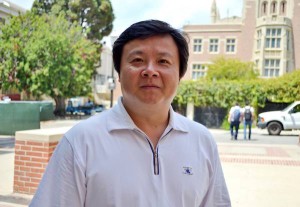
Metals are strong, durable materials—but with significant strength often comes significant weight.
Nonetheless, metals are so reliable as a material that they are instrumental in applications that span diverse industries, including aerospace, automobiles, electronics, and biomedical devices—all of which could significantly benefit from metals that deliver the same strength with reduced weight.

Xiaochun Li. Credit: UCLA
Now researchers at University of California Los Angeles and Missouri University of Science & Technology have a strategy to do just that. The team has developed a new super-strong yet super-lightweight metal nanocomposite—a metal that owes its surprising strength to ceramic nanoparticles.
“It’s been proposed that nanoparticles could really enhance the strength of metals without damaging their plasticity, especially light metals like magnesium, but no groups have been able to disperse ceramic nanoparticles in molten metals until now,” Xiaochun Li, Raytheon Chair in Manufacturing Engineering at UCLA and principal investigator on the research, says in a UCLA press release. “With an infusion of physics and materials processing, our method paves a new way to enhance the performance of many different kinds of metals by evenly infusing dense nanoparticles to enhance the performance of metals to meet energy and sustainability challenges in today’s society.”
Although the idea of adding ceramic particles to enhance the strength of metals is not new, getting the particles evenly dispersed has remained a persistent problem with this concept.

Lianyi Chen. Credit: Missouri S&T
“Ceramic particles have been used in metal matrices to further improve the strength of metals, but they tend to clump together, reducing the strengthening efficiency, degrading the metal’s plasticity and making them hard to machine,” Lianyi Chen, assistant professor of materials science and mechanical and aerospace engineering at Missouri S&T and lead author of the new research, says in a MS&T press release.
The UCLA–MS&T team has found a way around these past problems, using its technique to achieve a uniform distribution of silicon carbide nanoparticles in a magnesium-zinc alloy.
The scientists started with a low concentration of nanoparticles, adding just 1% by volume silicon carbide nanoparticles into the molten alloy. Evaporating the alloy within a vacuum furnace concentrated the nanoparticles, resulting in a final composition of ~14% silicon carbide and ~86% magnesium, the team reports in Nature.
“The evenly dispersed nanoparticles provide strength throughout the metal and improve plasticity simultaneously,” Chen says in the MS&T press release.
According to the UCLA release, homogenous distributed silicon carbide gives the metal record specific strength and specific modulus, and the metal nanocomposite retains excellent stability under high temperatures, too.
A Nature News & Views article about the research goes into a little more detail:
The resulting uniform distribution of nanoparticles is extremely effective in arresting basal slip and twin propagation, leading to an increase in the alloy’s yield strength (the stress at which the material starts to deform irreversibly) from around 50 MPa to around 410 MPa, without impairing plasticity. Chen and colleagues conferred further, extraordinary, strength on the alloy by reducing the size of the grains (small crystals) that make up the bulk metal. The resulting material has a yield strength of 710 MPa, the highest ever reported for polycrystalline magnesium alloys and their composites.

At left, a deformed sample of pure metal; at right, the strong new metal made of magnesium with silicon carbide nanoparticles. Each central micropillar is about 4 micrometers across. Credit: UCLA Scifacturing Laboratory
But how why did the nanoparticles distribute so evenly, when this problem has persistently plagued other researchers?
The authors hypothesize the process evenly disperses nanoparticles because of three reasons, they write in the paper’s methods. “The self-stabilization of dispersed SiC nanoparticles in magnesium melt is attributed to a synergy of reduced van der Waals forces between the nanoparticles in molten magnesium, a high thermal energy of the nanoparticles, and a high energy barrier preventing nanoparticle from sintering owing to a reasonable wettability between nanoparticles and molten magnesium.”
In addition to improving metal’s strength and plasticity, the researchers say their new technique is scalable, although this work is only the beginning.
“Although the method reported here is scalable in principle, many efforts are still needed to realize large-volume manufacturing from practical applications,” Chen says in the MS&T release.
The research paper, published in Nature, is “Processing and properties of magnesium containing a dense uniform dispersion of nanoparticles” (DOI: 10.1038/nature16445).
